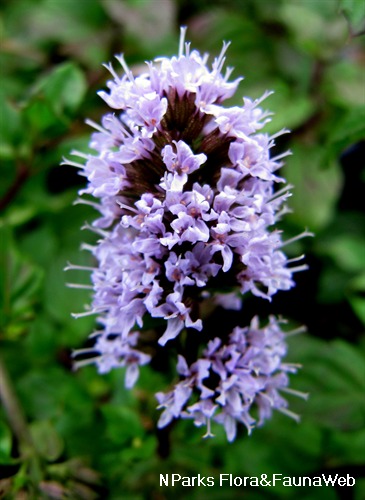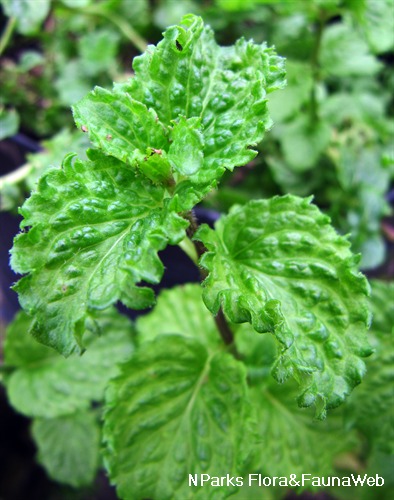
Back
Mentha longifolia (L.) Huds.
| Family Name: | Lamiaceae (Labiatae) |
| Synonyms: | Mentha spicata var. longifolia, Mentha spicata subsp. longifolia, Mentha incana, Mentha sylvestris |
| Common Name: | Silver Mint, Horsemint, 欧薄荷 |
Name
Classifications and Characteristics
| Plant Division | Angiosperms (Flowering Seed Plants) (Dicotyledon) |
|---|---|
| Plant Growth Form | Herbaceous Plant |
| Lifespan (in Singapore) | Perennial |
| Mode of Nutrition | Autotrophic |
| Maximum Height | 1 m |
Biogeography
| Native Distribution | Russia, Europe, Southwest Asia |
|---|---|
| Native Habitat | Terrestrial |
| Preferred Climate Zone | Temperate |
| Local Conservation Status | Non-native (Horticultural / Cultivated Only) |
Description and Ethnobotany
| Growth Form | Perennial herb with erect growth form up to 1 m tall. |
|---|---|
| Foliage | Whitish to greyish green leaves are egg-shaped to elongated, lance-shaped with a toothed leaf edge. The teeth are pointed to rounded and irregularly spaced along the margin. They have a strong mint fragrance, measure 6 cm x 1.5 cm and are densely covered by long, whitish hairs. |
| Stems | Whitish stems are branched, covered with short, soft hairs. |
| Flowers | Purplish flowers are densely arranged in a whorl-like patten on spike inflorescences measuring 3 to 8 cm long. |
| Fruit | Dry, indehiscent fruits are known as nutlets. The nutlets resemble seeds, but they are fruits produced from a 4-lobed ovary. |
| Cultivation | In Singapore, this plant is best grown under filtered sun and moderate watering. Amend the soil every 2-3 months by adding peatmoss or compost and gently forking it in the soil. Pinch the stem tips to promote bushy growth. Avoid planting in waterlogged soils, because the plant will quickly develop root rot. |
| Ethnobotanical Uses | Food (Herb or Spice): The leaves can be used to prepare an herbal tea. Medicinal: The essential oil has strong antimicrobial and antioxidant activity (Hajlaoui et al 2009). |
Landscaping Features
| Landscape Uses | Small Gardens, Container Planting |
|---|---|
| Thematic Landscaping | Economic Garden |
Plant Care and Propagation
| Light Preference | Semi-Shade |
|---|---|
| Water Preference | Moderate Water |
| Rootzone Tolerance | Well-Drained Soils, Fertile Loamy Soils |
Foliar
| Mature Foliage Colour(s) | Silver / Grey |
|---|---|
| Mature Foliage Texture(s) | Velvety / Furry / Tomentose |
| Prominent Young Flush Colour(s) | White |
| Young Flush Texture(s) | Velvety / Furry / Tomentose |
| Foliar Type | Simple / Unifoliate |
| Foliar Arrangement Along Stem | Opposite |
| Foliar Attachment to Stem | Petiolate |
| Foliar Shape(s) | Non-Palm Foliage (Ovate, Lanceolate, Oblong) |
| Foliar Venation | Pinnate / Net |
| Foliar Margin | Serrate / Toothed, Dentate |
| Foliar Apex - Tip | Acute |
| Foliar Base | Rounded / Obtuse, Cordate |
| Typical Foliar Area | Microphyll ( 2.25cm2 - 20.25 cm2 ) |
Floral (Angiosperm)
| Flower & Plant Sexuality | Bisexual Flowers |
| Flower Colour(s) | Purple |
|---|---|
| Flower Grouping | Cluster / Inflorescence |
| Flower Location | Terminal |
| Flower Symmetry | Bilateral |
| Individual Flower Shape | Tubular, Labiate / Lipped |
| Inflorescence Type | Spike, Verticel |
| Flowering Habit | Polycarpic |
Fruit, Seed and Spore
| Fruit Classification | Simple Fruit |
|---|---|
| Fruit Type | Indehiscent Dry Fruit , Nut / Nutlet |
Image Repository
Others
| Master ID | 31519 |
|---|---|
| Species ID | 5916 |
| Flora Disclaimer | The information in this website has been compiled from reliable sources, such as reference works on medicinal plants. It is not a substitute for medical advice or treatment and NParks does not purport to provide any medical advice. Readers should always consult his/her physician before using or consuming a plant for medicinal purposes. |




